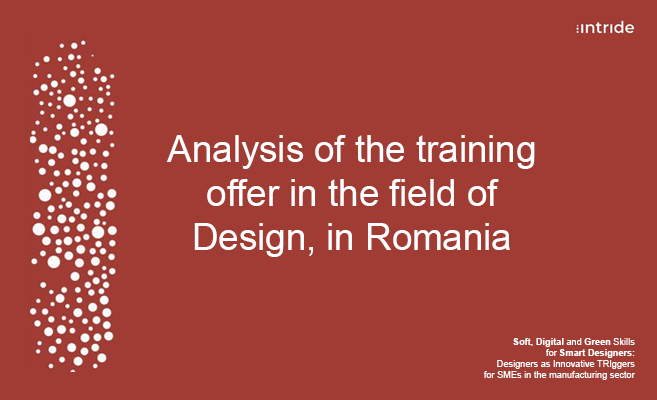Analysis of the training offer in the field of Design, in Romania

In order to settle a base for developing the structure and the learning modules of the Joint Master Programme within the framework of the Work package 4 of INTRIDE project, the teams from University of Art and Design in Cluj-Napoca and Transylvanian Furniture Cluster carried-out an analysis of the present training offer of the higher education institutions in Romania which provides courses in the field of Design. The analysis focused on the specific courses which assure the training in this field and the courses which could provide soft, digital and green skills for the graduates in this professional field.
As the study programs in the field of Design are provided in Romania by art universities and also, technical universities, the analysis contains information specific for each type of universities.
The traditional art universities in Romania which offer design programs are:
- National University of Arts in Bucharest;
- University of Art and Design in Cluj-Napoca;
- “George Enescu” University of Arts in Iași.
Each of these 3 university offer a B.A. Program in Design and a M.A. Program in Design. The PhD. Programs have the title of Visual Arts, but there are PhD student with research programs in the field of Design supervised by professors who teach Design.
The main objective of the study programs in the field of design offered by these universities is to develop complex abilities for the students, abilities which are capable to allow them to settle a relation between the artistic aspect and the technical one, in order to achieve the ability to create artistic, cultural and technical objects.
The identified purpose of the study programs in the field of design, offered by the art and design universities is to prepare students, so they could be able to anticipate and respond to complex dynamic needs, to assume responsibilities in the professional field, to promote the profession in areas where it can and should work.
The training wants to lead to skills and abilities of using the technologies and materials in order to develop products with a high coefficient of quality, functionality, aesthetics, operational safety, compatible with the required reference standards of the internal and international market.
There are many courses which have in their content diverse approaches of the sociological analysis, design thinking, the social values of the interactions: human being – object, human being – human being.
Most Digital skills that could be obtained are related to the Technical skills necessary to develop the design projects over all the study modules directed to product development, environmental design and graphic-design.
All the courses with a digital component contains concepts and applications of design elements and their relationships.
The other design programs are offered by the faculties of visual arts or faculties of design at the following universities, :
- West University of Timisoara, Faculty of Arts and Design;
- University of Oradea, Faculty of Arts, Visual Arts Department.
- “Aurel Vlaicu” University in Arad – Faculty of Design.
The didactical approach is similar with that of the art and design universities, because the study programs in the field of visual arts have a national strategy.
The programs in the field of design provided by the faculties with a technical orientation are offered by:
- Transilvania University of Brașov;
- Technical University in Cluj-Napoca.
Besides the common component of the syllabus of the design study programs (design theory and technology, color theory, computer graphics, electronic imaging and digital production), there are also specific courses at each faculty providing educational programs in the field of art and design.
The training offer in the field of engineering is diverse and there are many programs, at the above two mentioned universities, containing many courses which lead to acquiring soft, digital and green skills.
There are courses or modules of courses inside many study programs in the field of design at the universities in Romania, but it is necessary a coherent approach at national level.
If we think at the expected skills for graduating students, we have to consider that at the master’s degree level, students focus on studio skills and the development of expert technique, project management, and advanced design theory and applications.
Reviewing the full list of outcomes can reveal the academic focus of each study program, helping to bring a program’s goals into focus with personal career goals, taking in consideration the objective to reach the expected SDG Skills.
As regards the posible added components for the future master program developed with the framework of the INTRIDE Project, we list bellow few ideas:
- Media management in digital design: managing visual communications across a range of diverse channels;
- It is esential for the programs in design to offer skills for using the emerging media and get advanced knowledge of software and industry-standard tools.
